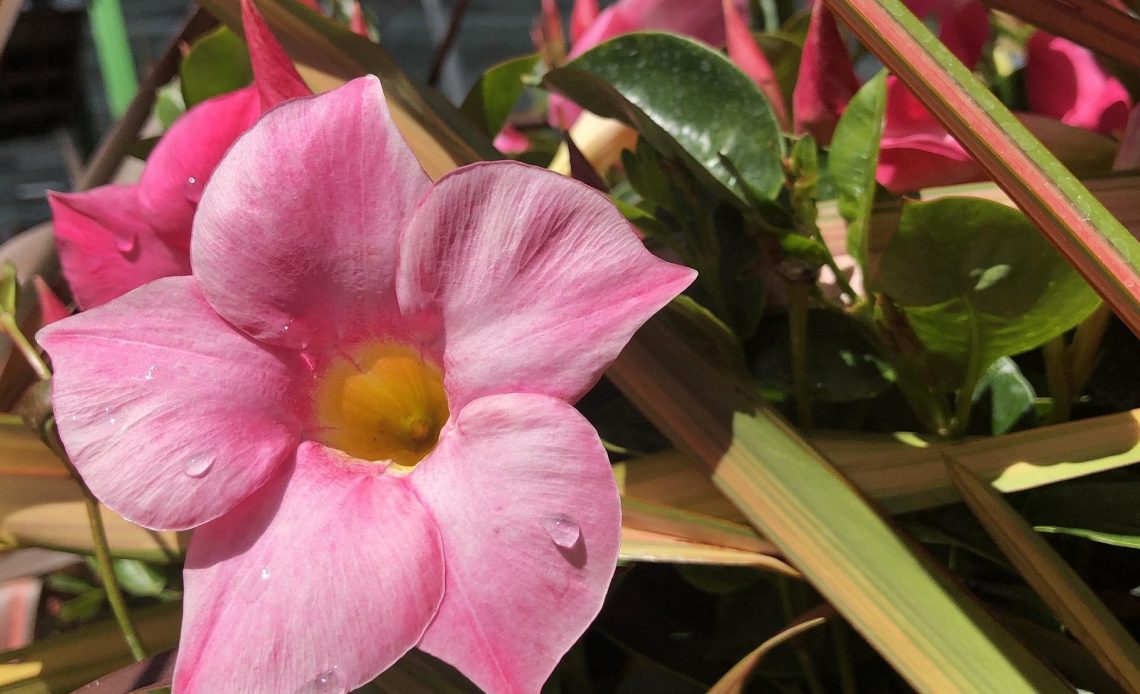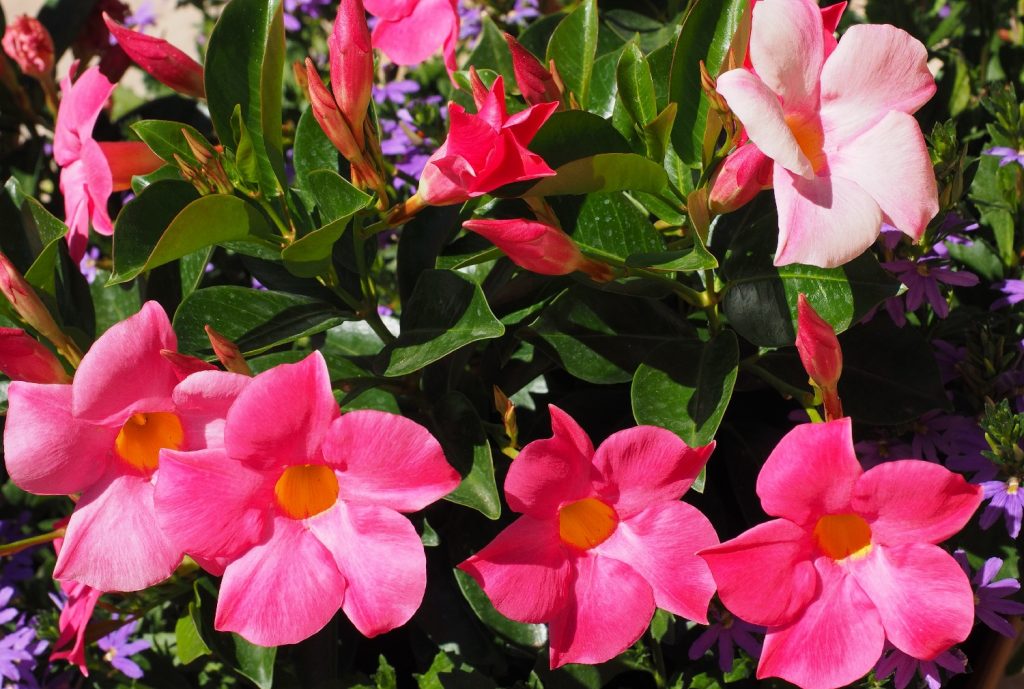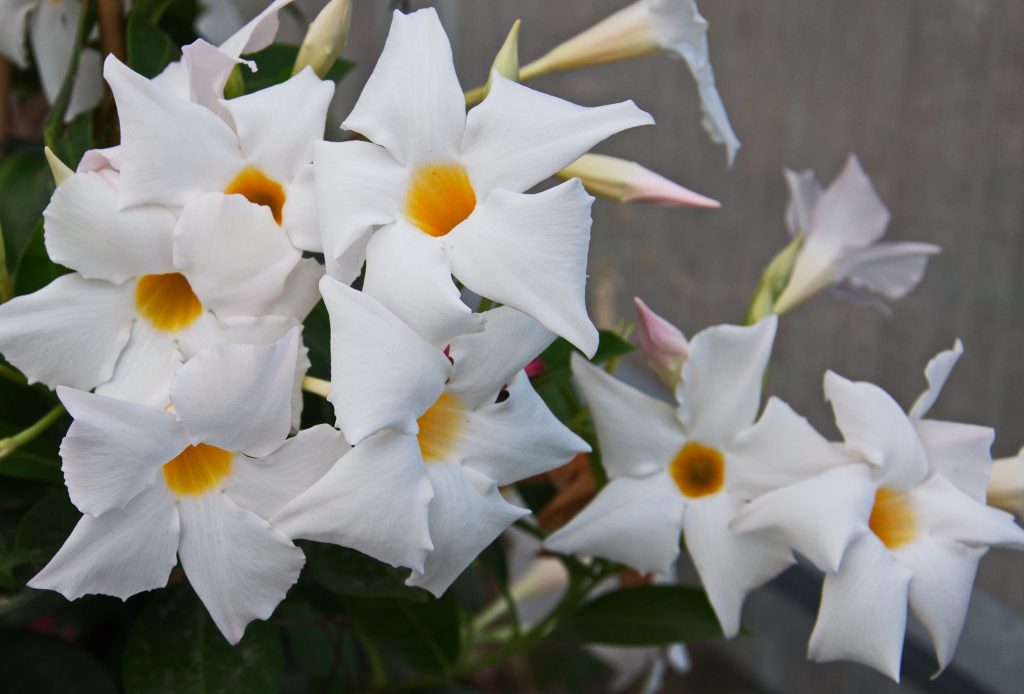

We’re here to help! Wild Yards is a completely free website that is 100% dedicated to helping you create a wildlife-friendly, sustainable yard. Read more
WildYards is reader-supported. When you buy a product through a link on our site, we may earn a comission. Every product is independently selected by our (obsessive) editors and our reviews are unbiased and objective. Read more about our mission or our privacy policy.
Planting a garden is one of the most rewarding things for an outdoor enthusiast. Flowering plants and shrubs are an excellent way to attract more wildlife to your backyard. But not everyone is born with a green thumb. If you’re looking for flowering plants that are as easy to care for as they are beautiful, you may be wondering if Rio Dipladenia is right for you.
Rio Dipladenia is very easy to grow, making it perfect for beginning gardeners. But its unparalleled beauty and ability to survive hot temperatures make it a popular choice with professional landscapers, too.
What is Rio Dipladenia?
A tropical vine featuring lush, dark green foliage and pink, white, orange, or red trumpet-shaped flowers, Rio Dipladenia thrives in zones 9 through 12. This plant is native to Brazil but can be found in other parts of South America, as well as Mexico, Central America, and the southern portion of the U.S, too.
Also sometimes known as Rio Mandevilla or Brazilian jasmine, Rio Dipladenia loves hot climates. It can be grown as a perennial where the weather stays warm year-round. However, it can survive farther north as a part of an annual flower garden, too. Rio Dipladenia can tolerate both dry and humid conditions and it is extremely drought-tolerant thanks to its tubers, which store water beneath the soil to help the plant through dry spells.
This vine reaches heights of about 10 feet in ideal conditions. It can also be trimmed to a smaller size if desired. Its versatility means it can be grown indoors as well as outside. If you want a breathtaking backyard space, but don’t have much time to dedicate to your plants, Rio Dipladenia offers the best of both worlds.
What are the ideal growing conditions for Rio Dipladenia?
Plant your Rio Dipladenia plants in well-draining soil, in a spot where they receive four or more hours of sunlight each day. This plant loves the heat. However, if you live in a region that stays exceptionally hot and dry with weeks of 100+ degree weather and scorching, blazing sunlight, try to find a spot that receives afternoon shade, instead.
Plants should be spaced 8” to 12” apart to allow for better oxygen and water circulation. Rio Dipladenia can be grown in raised beds, in large flower pots, or straight in the ground. You can plant your Rio Dipladenias at any time, but they grow best when planted in mid to late spring when conditions are moderate enough for them to get established before intense heat arrives.
Rio Dipladenias can be grown in cooler regions, too. However, they will not do as well. Cold temperatures, especially when combined with a lack of sunlight, stunt growth. If you live in a northern state, keep your Rio Dipladenia on a warm patio or on a sunny windowsill, where it will stay as warm as possible.
What’s the best way to care for Rio Dipladenia?
Rio Dipladenias should be watered every week or every other week when the soil is dry 2” down. These plants are very forgiving and can go weeks without a drop of water. Indeed, this plant prefers to have the soil dry out thoroughly before being watered again. Since it can go longer between waterings, it’s great for the traveling gardener or the flower newbie who forgets about their plants for days at a time.
In our experience, Rio Dipladenia does just fine without being babied too much. But if you want to give your plants some extra TLC, you can do so by fertilizing them with an all-purpose fertilizer once or twice a month. This helps provide them with everything they need to boost growth and ramp up flower production.
Deadheading is unnecessary. This plant’s flowers bloom, fade and fall off all on their own. If you do remove any dead flowers, toss them at the base of the plant, so they can be broken down into nutrients for the plant to use once more.

Does Rio Dipladenia attract pollinators and other wildlife?
As if there weren’t enough good reasons to grow Rio Dipladenia already, this plant is also awesome for attracting local wildlife. Rio Dipladenias are so colorful and so fragrant that they’re a hit with pollinators. The hummingbirds and butterflies in your region will flock to your new Rio Dipladenia plants in droves to feast on their sweet nectar.
While these plants attract all of the best wildlife, they keep the peskier creatures at bay. Deer and rabbits do not seem to enjoy the taste of Rio Dipladenia and will avoid it. Unless other food sources are scarce, you can keep your Rio Dipladenia outdoors safely without having to stress over protecting them from hungry foragers.
Are Rio Dipladenia plants susceptible to insects?
Spider mites and aphids are the two biggest threats to Rio Dipladenias when it comes to insects. Purchasing ladybugs to live in your Rio Dipladenias is an excellent natural pest control option that can help prevent bugs from destroying the other plants in your garden, too.
If you don’t have time to wait for ladybugs to defend your ornamentals, mix up a natural pollinator-safe pesticide. Dilute one to two tablespoons of vinegar in a cup and a half of water, and add 5 to 7 drops of neem oil. Spray this solution onto your Rio Dipladenia plants regularly, and don’t forget to re-spritz them after rain.
Diatomaceous earth can also eliminate insects — however, this won’t just kill the bad bugs, it will kill the good ones, too. Diatomaceous earth is a powder comprised of tiny sediment and microscopic fossilized algae that penetrates the exoskeletons of insects and causes them to dehydrate.
If you choose to use diatomaceous earth on your Rio Dipladenias, be careful not to inhale it. Though it is non-toxic, it is very drying and damaging to the sinuses. Wear a mask, goggles, and gloves to apply the dust to all parts of the plant.

How can you protect your Rio Dipladenia during the winter?
If your Rio Dipladenia plants are in pots, simply bring them inside and store them in a warm room, preferably where they still receive sunlight. If your plants are in the ground or raised beds, you’ll need to protect them. Cover the roots with a thick layer of mulch or straw to prevent the soil from getting too cold. And spread a thick cloth, like a packing blanket, over the tops of the plants to keep them warm.
If the temperatures in your region never go below 45 degrees in the winter, your Rio Dipladenia plants still need to be protected, but they will be okay outside. They may even be able to withstand light overnight freezes, though the vine itself may die back to the roots. But if you get hard freezes regularly, these plants won’t make it.
Rio Dipladenias slow their growth from late fall to early spring, so there’s no need to fertilize them over the winter. However, they can still get a little parched during this time. So it’s important to check the soil every week. If the soil is dry, give them a drink of water.
When is the best time to transplant your Rio Dipladenias?
If you want to move your Rio Dipladenias to a new location, it’s best to do so in late fall, winter, or early spring, when the plant is dormant. Take a trowel and dig a circle around your Rio Dipladenia, 6 to 8 inches away from the plant all the way around. This will allow you to avoid accidentally cutting through the roots and damaging the plant.
Once you’ve got the circle traced around the plant, slowly pry the soil beneath it upwards with a shovel. Make sure to include plenty of soil beneath the roots, and take as much soil with the plant as possible when you move it to its new home.
Next, loosen the soil in the new hole to allow for better root growth. You can amend the soil with organic matter or potting soil if it’s too sandy. Ensure the hole is larger around than the previous hole, and place the plant in it, mixing the new dirt with the old to prevent the plant from going into transplant shock when it emerges in the spring.
What’s the best way to encourage Rio Dipladenia growth in the spring?
Some careful pruning in the late fall or early winter will help improve performance in spring. Take a pair of sharp clippers and examine your plant for excessive growth. If you see multiple stems growing in one small section, thin them out to reshape the plant. Clip old stems and dying leaves away, too. This will help the plant focus on reinforcing its root system during its dormancy period.
Remember never to prune your Rio Dipladenia plants in the spring. Doing so may stunt flower production as the plant works to replace lost foliage. Additionally, you should wear long sleeves and gloves when handling your Rio Dipladenias, as the foliage contains oils that may irritate the skin.
Overall, Rio Dipladenia is a tropical ornamental that is super easy to care for. Its ability to attract pollinators and its resistance to unwanted pests make this one of the best flowers for amateur gardeners.

I enjoyed your article but you didn’t address my problem. There are large brown and dying areas in the leaves! Why and what can I do?
Hi Barbara, I’m so sorry to hear your rio dipladenia is struggling! What you’re describing sounds like either root rot or Anthracnose. First, make sure your plant isn’t getting too much water. Rio dipladenias like moist soil, but it should also drain well. Excess water can prevent air from reaching the roots, and that can contribute to brown spots and die back. If overwatering and/or root rot aren’t the issue here, then anthracnose could be the problem. This is a type of canker that leads to brown spots that can spread over the years. In this instance, you should remove all brown, diseased portions from the plant and spray it with a fungicide like this one. I hope this helps you, and good luck gardening!
I have both pink and white dipladenia plants, I absolutely love them I have not gone even 1 day without flowers on any of them. I live in Florida, as you mention above the plants thrive in the soil here. My specific question is: Why do the white flowered plants seem to droop while the pink stand straight up? I noticed a neighbor who also has the white has the same issue. Is this how the white just is?
Hi Tammy, what a great question! Interestingly, how flowers grow (whether the droop or grow upright) has nothing to do with their coloring, but rather their genetics. It’s possible that the white rio dipladenias are a different cultivar than the pink ones. It’s also worth noting that environmental stressors can cause some flowers to droop more quickly than others. The white rio dipladenias may be more sensitive to high humidity, warm temperatures, and sun exposure than the pink ones. So, ultimately, yes — it sounds like that’s just how the white flowers grow! Thank you for your question, and good luck gardening!
When my sister visited me in May, she brought me a beautiful 16″ hanging plant labeled “rio dipladenia” which had lots of red blossoms. I hung it from a rod-iron stand in a large planter surrounding a huge tree on my patio and enjoyed it every day…until the constant 100+-degree temps started to turn the leaves brown and the flowers quit blooming. Mostly it received direct sunlight but it also got about four hours of shade daily. Thinking it needed more water, I watered it every other day. Did I overwater it? What should I do to revive it?
Hi Jodi, it sounds like your rio dipladenia got too hot, and may have been overwatered. Even though these flowers can withstand high temperatures, they need some afternoon shade once the temperatures go above 90 degrees Fahrenheit, especially if it’s a dry heat. In extremely hot climates, it’s best for rio dipladenias to receive morning sun and afternoon shade. The best thing to do to revive the plant is move it to a cooler location, trim away the leaves and stems that are obviously dead, and scale back on watering. Check the plant’s soil to ensure good drainage, and always feel an inch below the surface of the soil before watering. If it still feels damp, wait until it feels dry to water again. One or two deep waterings per week is much better than smaller drinks more often. If you find the plant’s soil is drying out too quickly in between waterings, consider applying mulch (lawn clippings, hay, or wood chips would work well) to keep the soil moist and cool. You can use a mister to spritz the living foliage with water, which will help the plant retain moisture without running the risk of overwatering it. Just be patient, rio dipladenias are pretty resilient, so your plant should come back! Best of luck, and thank you so much for your question!
hi….i have 3 beautiful red dipladenias…..absolutely love them…
my question….i live in minnnesota…my plants are outside in pots..can i bring them in for the winter….and can i cut them back…they are huge…i don’t have a lot of room….
thank you
vicki
Hi Vicki! Yes, you can definitely bring your rio dipladenias indoors over the winter to keep them warm. And you can prune the plants back to a more manageable size, too, just be sure to wait until late fall to do so. Remove damaged, diseased, misshapen, and obviously dead leaves and stems first, then shape the plant. Limit the amount you prune to a third of the plant. Over-pruning can stress rio dipladenias, so be careful not to take off too much. Be sure to water the plants well after trimming them, and keep them in a warm area of your home during the winter. Consider using a humidifier to keep them hydrated, and give them plenty of light, either by placing them in front of a window or by using an LED light. When spring rolls back around, feed the plants a dose of 18-6-12 fertilizer to help them get growing again. Thank you so much for your question, and best of luck with your rio dipladenias!